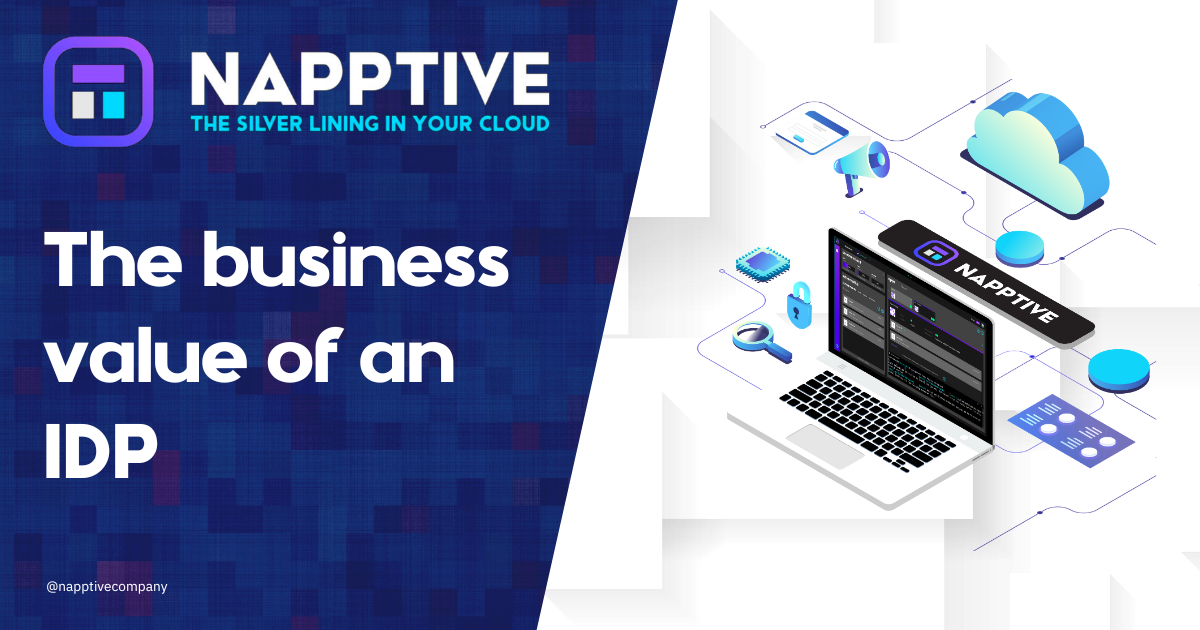The Business Value of an IDP
 Napptive
Napptive
Nowadays, customers expect to see their favorite applications to be refreshed frequently. As users, we can see that new features and improved functionality updates are constantly rolling in. How to keep up with the competitors’ pace and remain relevant in today’s fast-evolving world? In this article, we will break down how an Internal Developer Platform (IDP) is your best tool for drastically cutting back time to market.
Today’s market is constantly evolving with updates, avoid becoming stagnant!
Benefits of an Internal Developer Platform
An IDP is an internal product that developers use for their everyday work. It combines and integrates all the infrastructure, systems, and tools that they need to achieve maximum efficiency and productivity. As a secondary effect, it also translates into better collaboration, which adds to the goal of shipping updates faster. This is how an IDP achieves all this (and more!).
A. Efficiency and Productivity
An IDP provides a standardized, automated, and centralized ecosystem for development that will allow fast-release cycles:
Developer self-service – Developers have readily available all the tools they need to avoid halts in their workflow. With a few clicks, they have access to resources, environments, integrations, deployments, rollbacks, etc. instead of having to create tickets and wait for their resolution.
Promotion of automation culture – Save time by automating tasks such as application configuration or infrastructure management. For example, setting up a new environment is the most common requirement for fresh development, yet it takes a lot of time to manually create one. By streamlining operations, your organization makes more value of both your Dev and Ops teams’ time.
Lower cognitive load – Thanks to automation, IDPs also reduce complexity. Cloud-native applications have made managing and deploying software more complex, and not every developer is also an expert on, say, AWS, Kubernetes, or Terraform. A unified platform aids developers in building, testing, and deploying applications with ease, regardless of the underlying architecture.
In addition to this, there is something to be said about not only being more efficient but also more productive. Avoiding critical situations, easier auditing, and fast recovery are key in this sense. Internal Platforms enforce good practices and limit the chance of errors by the establishment of golden paths and role-based access control (RBAC). The platform becomes the place for centralized debugging information. All deployments are versioned. Rollbacks can be done automatically. A good portion of time devoted to failure-fixing can now be freed for adding value.
Some examples
To illustrate the advantages above, let’s recall some usual pains in software development in which an Internal Developer Platform can help:
There is a new developer in the company. If there aren’t golden paths, automated processes, or a centralized source of documentation, this person will need many hours to find out how things are done (and will likely misconfigure something).
When Development teams are ready to start testing in infrastructure, they have to ask an Operations team to provision it. They may be faced with long waits, maybe weeks, before they can continue working on this application, breaking workflows and trains of thought, and unnecessarily delaying its release.
Infrastructure and application configuration management are usually manual tasks that, in lack of an IDP, developers have to do, instead of using their time to do what they do best – develop.
As cloud computing becomes more and more prevalent, and without an IDP to reduce the complexity, organizations face the necessity to hire multi-skilled engineers who will be able to successfully handle all these new technologies – which, of course, is difficult and expensive.
B. Improved Collaboration
It seems counter-intuitive that a tool that promotes self-service will boost collaboration, but it’s true. There are a few factors that weigh in on this result. First of all, the Dev and Ops teams will have a golden opportunity to collaborate during the IDP adoption and maintenance. Developers must point out bottlenecks that Ops will work on alleviating. The Ops team in charge of the IDP should design ideal deployment pipelines and adjust them as developer necessities evolve over time.
Ideally, such pipelines include the publication of reusable components to the company’s catalog. Standardization and enforcement of good practices lead to consistency and cohesiveness in processes and the codebase. This lets developers from different teams jump into each other’s projects with minimal difficulty because they work with the same set of tools and follow the same best practices.
Cross-region collaboration is another area where an IDP shines. It empowers Development teams spread across the globe to work together seamlessly, enabling efficient knowledge sharing and fostering a culture of innovation. Tailored to the unique needs of your business
An IDP must integrate as much as possible with the organization’s existing infrastructure and culture. The technology culture of a company comprises the stack it uses, its tools, its codebase, and the set of processes being followed. The platform needs to comply with the existing – or desired – source code management, release management strategies, security, and other major processes.
Such a platform will meet all the organization’s needs and promote the goals that the stakeholders – the company, the developer teams, the operations teams, and the final clients – have set for it. Suppose that a company already uses Crossplane to enable developers to provision infrastructure using yaml files. A customized IDP can integrate the use of Crossplane so that the organization makes use of existing know-how. Letting developers use a well-known tool, instead of making them learn to use yet another one, will help in effectively reducing the cognitive load and resistance to change.
Real-World Examples of IDPs Generating Business Value
IDPs offer a scalable solution that can accommodate the needs of organizations, regardless of their size. Let’s see how three leading tech companies have brought in an IDP in their structure to solve problems they were struggling with.
Uber
Uber’s fragmented codebase created issues that permeated library versions, build tools, and dependency management, impacting collaboration and code sharing significantly. In response, Uber decided to transition developers to a remote development environment called DevPod. By consolidating all codebases into a single repository and centralizing the build platform, it managed to attain better dependency management, consistent universal production library versions, and improved support for a standard set of tools and processes. The cherry on the cake was the boosted visibility, collaboration, and code sharing that this transformation brought about.
Adidas
Adidas noticed that routine operations were slowing down the delivery process, curbing spontaneity, and impeding the fast-paced development work that the company needed to stay competitive. So they decided to completely overhaul their approach. They used a combination of advanced methodologies and tools: containerization, agile development, continuous delivery, and the induction of a cloud-native platform encompassing Kubernetes and Prometheus. By adopting these cutting-edge technologies, Adidas was able to create an efficient, streamlined Internal Developer Platform designed to improve speed, operability, and observability.
Spotify
Spotify’s Backstage is the best well-known IDP of this set. The company infrastructure had become a labyrinth of multifaceted tech stacks, redundant tasks, and disparate documentation, each making infrastructure management increasingly complex. To simplify and streamline the software development process, they set to create a platform that would offer a consistent interface, a standardized backend, and enough flexibility to allow teams to adapt it to their unique needs. Teams found themselves with more time and resources to devote to developing new features and services, rather than wrangling with a complicated infrastructure.
Conclusion
As Navdeep Singh Gill (global CEO of Xenon Stack) puts it in a Forbes article, “IDPs help rapidly growing enterprises focus on work that provides optimal business value.” By automating routinary tasks, developers can focus on adding value to the organization, releasing faster, bringing up innovative ideas, and engaging in fruitful collaboration. Shortening time-to-market is key in today’s fast-paced world. A self-service platform prevents dependency blocks and ensures Operations-approved configuration and infrastructure management.
If you want your company to take the next step towards reaching lightning-speed release cycles, consider using Napptive. It is a robust and versatile out-of-the-box IDP that can be customized to meet your business needs. Make the choice that will empower your operations and elevate your team’s productivity to new heights. Try Napptive completely free here.
Subscribe to my newsletter
Read articles from Napptive directly inside your inbox. Subscribe to the newsletter, and don't miss out.
Written by

Napptive
Napptive
We are a team of engineers at Napptive. Our platform was born with the idea of simplifying the way developers build, share and run cloud-native apps. The platform is suitable for developers, DevOps, and IT management teams so they can seamlessly create, deploy, and manage their apps in a self-service scalable platform, removing the burden of complex infrastructure and operations, and providing a cohesive cloud-native development experience. www.napptive.com